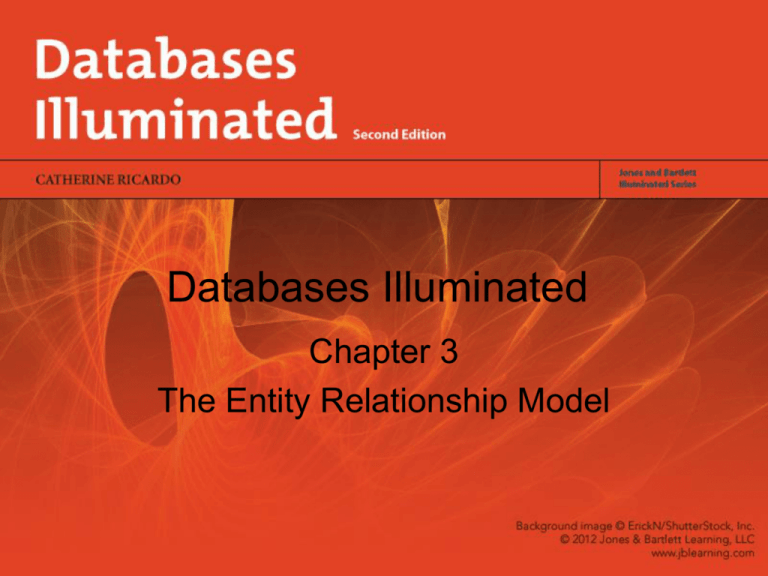The Entity-Relationship Model
advertisement

Databases Illuminated Chapter 3 The Entity Relationship Model Purpose of E-R Model • Facilitates database design • Express logical properties of mini-world of interest within enterprise - Universe of Discourse • Conceptual level model • Not limited to any particular DBMS • E-R diagrams used as design tools • A semantic model – captures meanings Symbols used in E-R Diagram • • • • Entity – rectangle Attribute – oval Relationship – diamond Link - line Entity • Object that exists and that can be distinguished from other objects • Can be person, place, event, object, concept in the real world • Can be physical object or abstraction • Entity instance is a particular person, place, etc. • Entity type is a category of entities • Entity set is a collection of entities of same type-must be well-defined • Entity type forms intension of entity – permanent definition part • Entity instances form extension of entity – all instances that fulfill the definition at the moment • In E-R diagram, rectangle represents entity set Attributes • • • • • Defining properties or qualities of entity type Represented by oval on E-R diagram Domain – set of allowable values for attribute Attribute maps entity set to domain May have null values for some entity instances – no mapping to domain for those instances • May be multi-valued – use double oval on E-R diagram • May be composite – use oval for composite attribute, with ovals for components • May be derived – use dashed oval Keys • Superkey: attribute or set of attributes that uniquely identifies an entity • Composite key: key with more than one attribute • Candidate key: superkey such that no proper subset of its attributes is also a superkey (minimal superkey –no unnecessary attributes) • Primary key: candidate key actually used for identifying entities and accessing records • Alternate key: candidate key not used for primary key • Secondary key: attribute or set of attributes used for accessing records, but not necessarily unique • Foreign key: term used in relational model (but not in the E-R model) for an attribute that is primary key of a table and is used to establish a relationship, usually with another table, where it appears as an attribute also Relationships • • • • Connections or interactions between entity instances Represented by diamond on E-R diagram Relationship type – category of relationships Relationship set – collection of relationships of same type, consists of relationship instances – relationships that exist at a given moment • Type forms intension; set forms extension of relationship • Relationship can have descriptive attributes • Degree of relationship – – – – Binary – links two entity sets; set of ordered pairs Ternary – links three entity sets; ordered triples N-ary – links n entity sets; ordered n-tuples Note: ternary relationships may sometimes be replaced by two binary relationships (see next 2 slides) Ternary Relationship Two Binary Relationships Cardinality of Relationships • Number of entity instances to which another entity can map under the relationship • One-to-one: X:Y is 1:1 is each entity in X is associated with at most one entity in Y and each entity in Y with at most one entity in X. • One-to-many: X:Y is 1:M is each entity in X can be associated with many entities in Y, but each entity in Y with at most one entity in X. • Many-to-many: X:Y is M:M if each entity in X can be associated with many entities in Y, and each entity in Y with many entities in X (many=more than one) The next slide shows several representation methods Showing Cardinalities on an E-R Diagram Relationship Participation Constraints • Total participation – Every member of entity set must participate in the relationship – Represented by double line from entity rectangle to relationship diamond • Partial participation – Not every entity instance must participate – Represented by single line from entity rectangle to relationship diamond Roles • Role: function that an entity plays in a relationship • Optional to name role of each entity, but helpful in cases of – Recursive relationship – entity set relates to itself – Multiple relationships between same entity sets Existence Dependency and Weak Entities • Entity Y is existence dependent on entity X is each instance of Y must have a corresponding instance of X • Y must have total participation in its relationship with X • If Y does not have its own candidate key, Y is called a weak entity, and X is strong entity • Weak entity may have a partial key, a discriminator, that distinguishes instances of the weak entity that are related to the same strong entity • Use double rectangle for weak entity, with double diamond for relationship connecting it to its strong entity • Note: not all existence dependent entities are weak – the lack of a key is essential to definition ER Diagram Example





